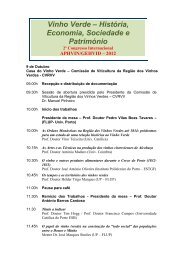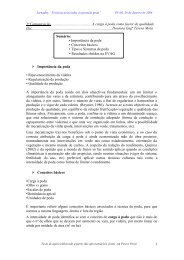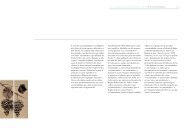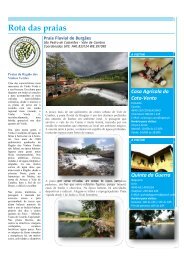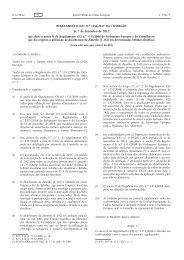CASTAS „AUTORIZADAS‟ para a produção de Vinho Verde ...
CASTAS „AUTORIZADAS‟ para a produção de Vinho Verde ...
CASTAS „AUTORIZADAS‟ para a produção de Vinho Verde ...
Create successful ePaper yourself
Turn your PDF publications into a flip-book with our unique Google optimized e-Paper software.
<strong>CASTAS</strong> <strong>„AUTORIZADAS‟</strong> <strong>para</strong> a<br />
<strong>produção</strong> <strong>de</strong> <strong>Vinho</strong> Ver<strong>de</strong>:<br />
actualização sinonímica e<br />
avaliação enológica em 2010<br />
Por: TERESA MOTA / EVAG - CVRVV<br />
VIII Jornadas Vitivinícolas 2010<br />
QUINTA CAMPOS DE LIMA, 7 <strong>de</strong> Dezembro <strong>de</strong> 2010
Fonte: Antero Lopes Martins (2009)<br />
1,0
CULTIVO TRADICIONAL /<br />
DIVERSIDADE DE <strong>CASTAS</strong><br />
(VARIABILIDADE INTERVARIETAL)<br />
Finais séc.XIX / Início séc.XX: 900<br />
varieda<strong>de</strong>s incluindo sinónimos<br />
(Bravo & Oliveira,1916)<br />
VINHAS CONTÍNUAS / POUCA<br />
DIVERSIDADE DE <strong>CASTAS</strong><br />
(EROSÃO GENÉTICA)
5 Sub-regiões CARTA DE LEI<br />
<strong>de</strong> 18 Set. e DECRETO <strong>de</strong> 1<br />
Out. 1908 Art. 10º<br />
1. Monção – <strong>Vinho</strong> Ver<strong>de</strong> <strong>de</strong><br />
Monção (Monção e Melgaço)<br />
2. Lima – <strong>Vinho</strong>s Ver<strong>de</strong>s do Lima<br />
(Viana do Castelo, Ponte do Lima,<br />
Ponte da Barca e Arcos <strong>de</strong><br />
Val<strong>de</strong>vez)<br />
3. Amarante – <strong>Vinho</strong>s Ver<strong>de</strong>s <strong>de</strong><br />
Amarante (Amarante e Marco <strong>de</strong><br />
Canavezes)<br />
4. Basto – <strong>Vinho</strong>s Ver<strong>de</strong>s <strong>de</strong> Basto<br />
(Celorico <strong>de</strong> Basto, Cabeceiras e<br />
Mondim <strong>de</strong> Basto)<br />
5. Braga – <strong>Vinho</strong>s Ver<strong>de</strong>s <strong>de</strong> Braga<br />
(Barcelos, Braga, Guimarães,<br />
Amares, Póvoa <strong>de</strong> Lanhoso, Vila<br />
Nova <strong>de</strong> Famalicão, Vila Ver<strong>de</strong> e<br />
Esposen<strong>de</strong>)<br />
2<br />
5<br />
1<br />
3<br />
4
6 Sub-regiões DECRETO 12<br />
866 <strong>de</strong> 10 Dez.1926 Art.2º<br />
1. Monção (Monção e Melgaço)<br />
2. Lima (Viana do Castelo, Ponte do<br />
Lima, Ponte da Barca e Arcos <strong>de</strong><br />
Val<strong>de</strong>vez)<br />
3. Braga (Barcelos, Braga,<br />
Guimarães, Amares, Póvoa <strong>de</strong><br />
Lanhoso, Vieira, Vila Nova <strong>de</strong><br />
Famalicão, Vila Ver<strong>de</strong> e<br />
Esposen<strong>de</strong> e Fafe)<br />
4. Basto (Celorico <strong>de</strong> Basto,<br />
Cabeceiras <strong>de</strong> Basto e Mondim <strong>de</strong><br />
Basto)<br />
5. Amarante (Amarante e Marco <strong>de</strong><br />
Canavezes)<br />
6. Penafiel (Penafiel, Lousada,<br />
Felgueiras, Pare<strong>de</strong>s e Paços <strong>de</strong><br />
Ferreira)<br />
2<br />
3<br />
1<br />
6<br />
5<br />
4
6 Sub-regiões DECRETO 16<br />
684 <strong>de</strong> 22 Mar.1929<br />
1. Monção (Monção e Melgaço)<br />
2. Lima (Viana do Castelo, Ponte do<br />
Lima, Ponte da Barca e Arcos <strong>de</strong><br />
Val<strong>de</strong>vez)<br />
3. Braga (Barcelos, Braga,<br />
Guimarães, Amares, Póvoa <strong>de</strong><br />
Lanhoso, Vieira, Vila Nova <strong>de</strong><br />
Famalicão, Vila Ver<strong>de</strong> e<br />
Esposen<strong>de</strong> e Fafe) + Santo Tirso<br />
4. Basto (Celorico <strong>de</strong> Basto,<br />
Cabeceiras <strong>de</strong> Basto e Mondim <strong>de</strong><br />
Basto) + Ribeira <strong>de</strong> Pena<br />
5. Amarante (Amarante e Marco <strong>de</strong><br />
Canavezes)<br />
6. Penafiel (Penafiel, Lousada,<br />
Felgueiras, Pare<strong>de</strong>s e Paços <strong>de</strong><br />
Ferreira)<br />
2<br />
3<br />
1<br />
6<br />
5<br />
4
9 Sub-regiões PORTARIA<br />
28 <strong>de</strong> 16 Jan. 2001 Art.1º MONÇÃO<br />
1. Monção (Monção e Melgaço)<br />
2. Lima (Viana do Castelo, Ponte do<br />
Lima, Ponte da Barca e Arcos <strong>de</strong><br />
Val<strong>de</strong>vez)<br />
3. Cávado (Terras <strong>de</strong> Bouro, Amares,<br />
Vila Ver<strong>de</strong>, Braga, Barcelos e<br />
Esposen<strong>de</strong>)<br />
4. Ave (Vieira do Minho, Póvoa <strong>de</strong><br />
Lanhoso, Fafe, Guimarães, Vizela, Vila<br />
Nova <strong>de</strong> Famalicão , Santo Tirso,<br />
Trofa, Póvoa <strong>de</strong> Varzim e Vila do<br />
Con<strong>de</strong>)<br />
5. Basto (Celorico <strong>de</strong> Basto, Mondim <strong>de</strong><br />
Basto, Cabeceiras <strong>de</strong> Basto e Ribeira<br />
<strong>de</strong> Pena)<br />
6. Amarante (Amarante e Marco <strong>de</strong><br />
Canavezes)<br />
7. Sousa (Penafiel, Pare<strong>de</strong>s, Paços <strong>de</strong><br />
Ferreira, Lousada e Felgueiras)<br />
8. Paiva (Castelo <strong>de</strong> Paiva)<br />
9. Baião (Baião, Resen<strong>de</strong> e Cinfães)
<strong>CASTAS</strong>: habitat vs plasticida<strong>de</strong><br />
Negrão
Encepamento das Denominações Subregionais<br />
(Portaria 28/2001 <strong>de</strong> 16 Jan.)<br />
1 2 3 4<br />
7<br />
5<br />
100%<br />
6<br />
1 2 3 4<br />
6<br />
Anho<br />
X<br />
100%<br />
8<br />
5<br />
7
00%<br />
50%<br />
0%<br />
25%<br />
75%<br />
100%<br />
25%<br />
75%<br />
100%<br />
até 2001 após 2001 até 2001 após 2001
� D-L nº 38 525 <strong>de</strong> 23 Nov. 1951 art.14º<br />
� PORTARIA nº 14 491 <strong>de</strong> 7 Ago. 1953<br />
� PORTARIA nº 701 <strong>de</strong> 13 Out. 1973<br />
� PORTARIA nº 195 <strong>de</strong> 10 Abr. 1985<br />
� D-L nº10 <strong>de</strong> 3 Fev. 1992<br />
� D-L nº 449/99<br />
� PORTARIA Nº 28 <strong>de</strong> 16 <strong>de</strong> Jan. 2001<br />
� PORTARIA nº 668 <strong>de</strong> 11 Ago. 2010<br />
20 ANOS<br />
12 ANOS<br />
7 ANOS<br />
7 ANOS<br />
2 ANOS<br />
9 ANOS<br />
Até 1985 todas as listas consi<strong>de</strong>ravam %s mínimas <strong>de</strong> Castas Obrigatórias<br />
(ou Recomendadas) e % máximas <strong>de</strong> Castas Ainda Aconselháveis (ou<br />
autorizadas)<br />
Em 1992 as percentagens só constam <strong>para</strong> as Sub-Regiões <strong>de</strong>ixando <strong>de</strong><br />
figurar <strong>para</strong> os DO <strong>Vinho</strong> Ver<strong>de</strong> e em 2001 e 2010 <strong>de</strong>saparecem <strong>de</strong> ambas as<br />
listas, obrigando as Sub-regiões a usarem em exclusivo as recomendads
Portaria nº 668/2010, D.R., 1.ª série — N.º 155 — 11 <strong>de</strong> Agosto <strong>de</strong> 2010<br />
ANEXO II do Art.5º Castas aptas à <strong>produção</strong> <strong>de</strong> vinhos e produtos<br />
vitivinícolas com direito à DO «vinho ver<strong>de</strong>». (Total: 45)<br />
Referência / Nome<br />
principal<br />
15 Alvarinho<br />
22 Arinto<br />
28 Avesso<br />
29 Azal<br />
39 Batoca<br />
60 Cainho<br />
73 Cascal<br />
106 Diagalves<br />
118 Esganinho<br />
119 Esganoso<br />
125 Fernão -Pires<br />
128 Folgasão<br />
139 Go<strong>de</strong>lho<br />
157 Lameiro<br />
162 Loureiro<br />
175 Malvasia -Fina<br />
179 Malvasia -Rei<br />
233 Pintosa<br />
265 São Mame<strong>de</strong><br />
271 Semillon<br />
272 Sercial<br />
278 Tália<br />
314 Trajadura<br />
Sinónimo<br />
reconhecido<br />
Pe<strong>de</strong>rnã<br />
Maria -Gomes<br />
245 Rabo-<strong>de</strong>-<br />
Ovelha = Rabigato<br />
Esgana –Cão<br />
Cor<br />
B<br />
B<br />
B<br />
B<br />
B<br />
B<br />
B<br />
B<br />
B<br />
B<br />
B<br />
B<br />
B<br />
B<br />
B<br />
B<br />
B<br />
B<br />
B<br />
B<br />
B<br />
B<br />
B<br />
Referência / Nome<br />
principal<br />
5 Alicante -Bouschet<br />
12 Alvarelhão<br />
16 Amaral<br />
31 Baga<br />
46 Borraçal<br />
107 Doçal<br />
108 Doce<br />
120 Espa<strong>de</strong>iro<br />
121 Espa<strong>de</strong>iro –Mole<br />
148 Grand –Noir<br />
156 Labrusco<br />
204 Mourisco<br />
214 Pa<strong>de</strong>iro<br />
219 Pedral<br />
226 Pical<br />
243 Rabo -<strong>de</strong> -Anho<br />
276 Sousão<br />
313 Touriga -Nacional<br />
317 Trinca<strong>de</strong>ira<br />
332 Ver<strong>de</strong>lho -Tinto<br />
334 Verdial -Tinto<br />
335 Vinhão<br />
Sinónimo<br />
reconhecido<br />
Tinta -Amarela<br />
Cor<br />
T<br />
T<br />
T<br />
T<br />
T<br />
T<br />
T<br />
T<br />
T<br />
T<br />
T<br />
T<br />
T<br />
T<br />
T<br />
T<br />
T<br />
T<br />
T<br />
T<br />
T<br />
T
SUB-REGIÃO DO SOUSA<br />
RABIGATO = RABO DE OVELHA = MÉDOC<br />
DOURADINHA = TÁLIA = PERA DE BODE = UGNI BLANC =<br />
TREBBIANO TOSCANO<br />
SEMILÃO = COLOMBARD<br />
SEMILÃO = SEMILLON<br />
Além do Rabo-<strong>de</strong>-Ovelha também o Colombard <strong>de</strong>veria entrar<br />
na lista das castas.
…excluindo as 7 castas brancas e 8 castas tintas “recomendadas”<br />
<strong>para</strong> a <strong>produção</strong> <strong>de</strong> vinhos com indicação <strong>de</strong> sub-região... ficam as<br />
estas castas que só po<strong>de</strong>rão entrar na <strong>produção</strong> <strong>de</strong> DO <strong>Vinho</strong> Ver<strong>de</strong>.<br />
Referência / Nome<br />
principal<br />
Sinónimo<br />
reconhecido<br />
60 Cainho<br />
73 Cascal<br />
106 Diagalves<br />
118 Esganinho<br />
119 Esganoso<br />
125 Fernão -Pires Maria-Gomes<br />
128 Folgasão<br />
139 Go<strong>de</strong>lho<br />
157 Lameiro<br />
175 Malvasia -Fina<br />
179 Malvasia -Rei<br />
233 Pintosa 245 Rabo-<strong>de</strong> Ovelha<br />
265 São Mame<strong>de</strong><br />
271 Semillon<br />
272 Sercial Esgana –Cão<br />
278 Tália<br />
16 BRANCAS<br />
C<br />
o<br />
r<br />
B<br />
B<br />
B<br />
B<br />
B<br />
B<br />
B<br />
B<br />
B<br />
B<br />
B<br />
B<br />
B<br />
B<br />
B<br />
B<br />
Referência / Nome<br />
principal<br />
5 Alicante -Bouschet<br />
31 Baga<br />
107 Doçal<br />
108 Doce<br />
121 Espa<strong>de</strong>iro –Mole<br />
148 Grand –Noir<br />
156 Labrusco<br />
204 Mourisco<br />
226 Pical<br />
276 Sousão<br />
313 Touriga -Nacional<br />
317 Trinca<strong>de</strong>ira<br />
332 Ver<strong>de</strong>lho -Tinto<br />
334 Verdial -Tinto<br />
14 TINTAS<br />
Sinónimo<br />
reconhecido<br />
Tinta -Amarela<br />
C<br />
o<br />
r<br />
T<br />
T<br />
T<br />
T<br />
T<br />
T<br />
T<br />
T<br />
T<br />
T<br />
T<br />
T<br />
T<br />
T
<strong>CASTAS</strong> só da REGIÃO<br />
DOS VERDES<br />
• A maior parte EM EXTINÇÃO, com o <strong>de</strong>saparecimento<br />
da pequena proprieda<strong>de</strong> dado que os exemplares que<br />
existem na região são <strong>de</strong> cultivo antigo e portanto em<br />
formas tradicionais.<br />
• Encontrando-se todavia „em guarda‟ na colecção<br />
ampelográfica da EVAG, muito embora muitas <strong>de</strong>las<br />
sem INTRAvariabilida<strong>de</strong> uma vez que estão<br />
representadas por um só clone.
PICAL<br />
CAINHO<br />
ESGANOSO<br />
ESGANA-CÃO<br />
LAMEIRO<br />
SÃO MAMEDE<br />
DOÇAL<br />
DOCE<br />
VERDELHO<br />
PINTOSA<br />
CASCAL<br />
MALVASIA-REI<br />
MALVASIA-FINA<br />
TRINCADEIRA<br />
BAGA<br />
RABO-DE-OVELHA Douro ao Ave – vinho no geral mau<br />
TÁLIA SOUSÃO<br />
Ave ao Cávado – vinho no geral<br />
VERDIAL<br />
mediocre<br />
ALIC. BOUSCHET<br />
Cávado ao Lima – vinho no geral bom<br />
G N DE LA<br />
Lima ao Minho – vinho no geral muito<br />
CALMETTE<br />
bom<br />
Basto e Ribeira Tâmega – vinho em<br />
geral excellente<br />
LABRUSCO<br />
SERCIAL<br />
….havendo sem dúvida honrosas<br />
excepções a fazer…<br />
Fonte: Viscon<strong>de</strong> <strong>de</strong> Villa Maior cit.<br />
Viscon<strong>de</strong> Villarinho <strong>de</strong> S.Romão (1902)
SUB-REGIÃO DE MONÇÃO<br />
NEGRÃO ou ESPADEIRO PRETO= VINHÃO<br />
BRANCELHO (ÃO)= ALVARELHÃO<br />
PEDRAL= ALVARINHO TINTO<br />
PICAL = PIQUE-POUL N<br />
FERNÃO PIRES = ALVARINHÃO
SUB-REGIÃO DO LIMA<br />
DOURADO = LOUREIRO<br />
GALEGO OU GALEGUINHO = ALVARINHO
SUB-REGIÃO DE BASTO<br />
SOUSÃO VERMELHO = GRAND NOIR DE LA<br />
CALMETTE<br />
RABO DE OVELHA = RABO-DE-ANHO
SUB-REGIÃO DO CÁVADO<br />
TINTO-CÃO = TINTO MATIAS = D.PEDRO = PADEIRO
Cainho <strong>de</strong> Moreira<br />
ou Cainho Branco<br />
ou Alvarinho Espanhol<br />
Caiño blanco (Galiza)<br />
TAP % 14,1%<br />
Açúcares redutores 238,7 g/L<br />
Ac.Total 5,0 g ác. tar./L<br />
Ác. Málico g/L 3,3 g/L<br />
Ác.Tartárico g/L 3,7 g/L<br />
pH 3,51
Morrão<br />
ou Terrantez<br />
ou Pé <strong>de</strong> Perdiz<br />
≠ Torrontez (Galiza) =<br />
Malvasia fina<br />
TAP % 13,9%<br />
Açúcares redutores 233,2 g/L<br />
Ac.Total 3,9 g ác. tar./L<br />
Ác. Málico g/L 2,7 g/L<br />
Ác.Tartárico g/L 3,2 g/L<br />
pH 3,76
Esgana-cão<br />
≠ Esgana-cão (Douro)<br />
ou Sercial<br />
TAP % 9,4%<br />
Açúcares redutores 158,2 g/L<br />
Ac.Total 5,4 g ác. tar./L<br />
Ác. Málico g/L 2,8 g/L<br />
Ác.Tartárico g/L 3,3 g/L<br />
pH 3,39
Lameira ou Lameirinho<br />
ou Luzidio<br />
ou Molarinho<br />
ou Branco da Lama<br />
≠ Branco da Lama<br />
(Galiza) = Batoca<br />
TAP % 13,2%<br />
Açúcares redutores 221,6 g/L<br />
Ac.Total 5,0 g ác. tar./L<br />
Ác. Málico g/L 2,2 g/L<br />
Ác.Tartárico g/L 3,5 g/L<br />
pH 3,41
Esganoso <strong>de</strong> Pte do Lima<br />
ou Esgana-cão<br />
≠ Esganinho, do Esganoso<br />
Ctlo Paiva e <strong>de</strong> outros<br />
Esgana-Cães<br />
TAP % 13,0 %<br />
Açúcares redutores 219,3 g/L<br />
Ac.Total 5,5 g ác. tar./L<br />
Ác. Málico g/L 4,2 g/L<br />
Ác.Tartárico g/L 3,6 g/L<br />
pH 3,72
Esganoso <strong>de</strong> Ctlo Paiva<br />
ou Esgana-cão<br />
ou Furricoso<br />
═ Esgana-Cão (Douro) =<br />
Esgana (Rib./Oeste) e ao<br />
Sercial (Ma<strong>de</strong>ira)<br />
TAP % 13,4%<br />
Açúcares redutores 226,2 g/L<br />
Ac.Total 5,1 g ác. tar./L<br />
Ác. Málico g/L 0,8 g/L<br />
Ác.Tartárico g/L 4,9 g/L<br />
pH 3,15
Branco-Escola<br />
ou Asal <strong>de</strong> Sto Tirso<br />
ou Branco <strong>de</strong> Asa<br />
ou Falso Loureiro<br />
ou Borrado das Moscas<br />
TAP % 12,1%<br />
Açúcares redutores 203,3 g/L<br />
Ac.Total 5,0 g ác. tar./L<br />
Ác. Málico g/L 2,2 g/L<br />
Ác.Tartárico g/L 3,4 g/L<br />
pH 3,32
Ver<strong>de</strong>lho branco<br />
ou Espa<strong>de</strong>iro-Loureiro<br />
TAP % 13,0%<br />
Açúcares redutores 219,3 g/L<br />
Ac.Total 9,0 g ác. tar./L<br />
Ác. Málico g/L 3,6 g/L<br />
Ác.Tartárico g/L 4,7 g/L<br />
pH 2,98
Vinhão Mole<br />
ou Espa<strong>de</strong>iro da Terra<br />
ou Espa<strong>de</strong>iro Femeeiro<br />
ou Ver<strong>de</strong>lho da Sombra<br />
ou Espa<strong>de</strong>iro<br />
═ Ferrol ou Cainho do<br />
Freixo(Galiza)<br />
TAP % 13,9%<br />
Açúcares redutores 233,2 g/L<br />
Ac.Total 6,3 g ác. tar./L<br />
Ác. Málico g/L 2,1 g/L<br />
Ác.Tartárico g/L 4,6 g/L<br />
pH 3,30
Doçar<br />
ou Espa<strong>de</strong>iro Doce / Doçal<br />
Aragão<br />
ou Ver<strong>de</strong>lho Doce / Folhal<br />
ou Doçal miúdo /Borralho<br />
TAP % 12,1%<br />
Açúcares redutores 203,3 g/L<br />
Ac.Total 3,6 g ác. tar./L<br />
Ác. Málico g/L 1,0 g/L<br />
Ác.Tartárico g/L 3,4 g/L<br />
pH 3,81
Doçal <strong>de</strong> Refóios<br />
TAP % 13,4%<br />
Açúcares redutores 226,2 g/L<br />
Ac.Total 3,3 g ác. tar./L<br />
Ác. Málico g/L 1,7 g/L<br />
Ác.Tartárico g/L 3,5 g/L<br />
pH 3,73
Que Lambrusco???<br />
TAP % 13,5%<br />
Açúcares redutores 227,4 g/L<br />
Ac.Total 5,0 g ác. tar./L<br />
Ác. Málico g/L 1,2 g/L<br />
Ác.Tartárico g/L 4,3 g/L<br />
pH 3,03
Sezão<br />
ou Sousão Forte<br />
ou Sousão <strong>de</strong> Correr<br />
≠ Sousão Galego<br />
TAP % 11,0 %<br />
Açúcares redutores 185,1 g/L<br />
Ac.Total 6,3 g ác. tar./L<br />
Ác. Málico g/L 1,5 g/L<br />
Ác.Tartárico g/L 5,0 g/L<br />
pH 3,01
Ber<strong>de</strong>lho<br />
ou Ver<strong>de</strong>lho Feijão<br />
ou Feijão<br />
ou Miu<strong>de</strong>sso<br />
≠ Ver<strong>de</strong>lho Quelho<br />
TAP % 12,4%<br />
Açúcares redutores 207,8 g/L<br />
Ac.Total 4,7 g ác. tar./L<br />
Ác. Málico g/L 1,9 g/L<br />
Ác.Tartárico g/L 4,0 g/L<br />
pH 3,44
Ver<strong>de</strong>al<br />
═ Melhorio<br />
TAP % 9,5 %<br />
Açúcares redutores 160,4 g/L<br />
Ac.Total 9,1 g ác. tar./L<br />
Ác. Málico g/L 4,0 g/L<br />
Ác.Tartárico g/L 5,0 g/L<br />
pH 2,98
� Houve sempre a percepção do mesmo nome <strong>para</strong><br />
‘coisas’ diferentes, daí o plural …<br />
� A adopção do nome AMARAL em vez <strong>de</strong> AZAL TINTO<br />
não foi pacífica<br />
� Para nós houve sempre o AMARAL - CASTA e o AMARAL<br />
- SINÓNIMO <strong>de</strong> Azal tinto<br />
� Por outro lado, o termo AZAL nada põe <strong>de</strong> comum<br />
entre o Azal branco e tinto<br />
� Mas na realida<strong>de</strong> ao adoptarmos o termo AMARAL<br />
per<strong>de</strong>mos 1 casta das listas… ou então mais…
Azal tinto (ou<br />
Azar)<br />
Amaral<br />
(Penafiel/Amarante)<br />
Cainho bravo<br />
Cainho miúdo<br />
(Monção)<br />
Cainzinho<br />
(Arcos <strong>de</strong> Val<strong>de</strong>vez)<br />
Sousão Galego<br />
(Basto)<br />
Fonte: Mota &Silva (1986)
Fonte: António Batalha Reis (1919)<br />
Em algumas regiões do Minho<br />
chamada TOURIGA mas diferente<br />
da do Douro…em justa<br />
proporção com o Alvarelhão em<br />
AMARANTE dá um dos melhores<br />
tipos <strong>de</strong> vinho…existem duas<br />
varieda<strong>de</strong>s principais…<br />
AZAL DOCE(muito produtivo e <strong>de</strong><br />
qualida<strong>de</strong>) e AZAL AZEDO (pouco<br />
produtivo e fraco) distinguidos já no<br />
final do séc.XIX<br />
Fonte: Viscon<strong>de</strong> <strong>de</strong> Villarinho <strong>de</strong><br />
S.Romão (1902)
Casta <strong>de</strong> gran<strong>de</strong> polimorismo, hoje i<strong>de</strong>ntificados diversos<br />
genótipos (castas) pela técnica <strong>de</strong> microssatélites, razão dos<br />
numerosos nomes conhecidos correcta ou incorrectamente.<br />
Fonte: Isaura Castro et al (2010)<br />
0.45 0.52 0.59 0.66 0.73 0.79 0.86 0.93 1.00<br />
Das 15 amostras analisadas foram i<strong>de</strong>ntificados grupos distintos <strong>de</strong> genótipos:<br />
• um grupo <strong>de</strong> 8 amostras com o mesmo genótipo<br />
• um grupo <strong>de</strong> 3 amostras com o mesmo genótipo<br />
• 4 genótipos diferentes nas restantes 4 amostras<br />
Azal Tinto-UTAD<br />
Amaral-EVN<br />
AT-1<br />
Amaral-1<br />
Azal Tinto-EVAG<br />
AT-2<br />
AT-9<br />
AT-7<br />
AT-6<br />
AT-5<br />
AT-8<br />
AT-3<br />
Amaral-2<br />
Sousão Galego<br />
AT-4<br />
•Conclusão: 6 <strong>CASTAS</strong> DIFERENTES?
� Há razões <strong>para</strong> consi<strong>de</strong>rar uma casta distinta<br />
do Azal tinto, tendo-o sido sempre nas<br />
colecções, e este ano na EVAG produziu<br />
cachos enormes (incompatível com o Azal)<br />
� Também não tem nada a ver com o Sousão<br />
ou Sezão ou Sousão Forte ou Sousão <strong>de</strong> correr<br />
� É referida como casta distinta por Duarte<br />
&Oliveira(1916) e pelo Eng.Pinho em 1967<br />
� É parecida ampelograficamente com a casta<br />
Loureiro<br />
� Pelos análise dos microssatélites <strong>de</strong>u ‘igual’<br />
ao Loureiro…
Em termos <strong>de</strong> conclusão:<br />
AS COLECÇÕES AMPELOGRÁFICAS<br />
SÃO PARTE DO MUSEU VIVO DE<br />
CADA REGIÃO<br />
E<br />
SÃO A EXPRESSÃO ‘MÁXIMA’ DA<br />
BIODIVERSIDADE!
� Haveria hoje possibilida<strong>de</strong> <strong>de</strong><br />
recuperar alguma <strong>de</strong>stas castas em<br />
extinção? (QUEM interroga?) (QUEM vai<br />
interrogar?) (ONDE procurar?)<br />
� Haveria a hipótese <strong>de</strong> hoje<br />
i<strong>de</strong>ntificarmos um genótipo tinto <strong>de</strong><br />
uma casta tão importante como é o<br />
Loureiro?<br />
OBRIGADO



